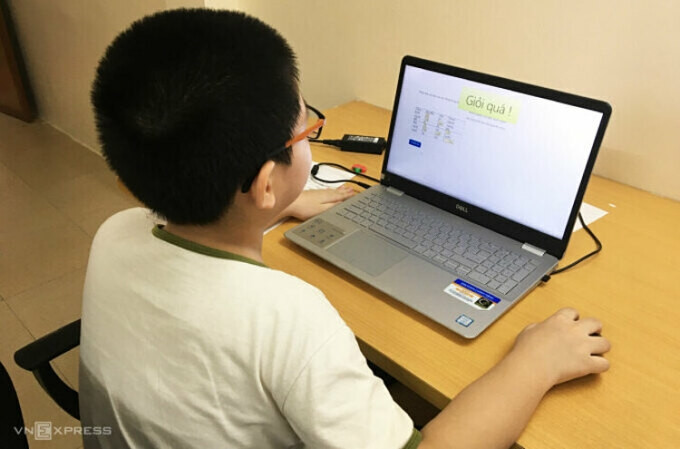Place the computer screen in the correct position, sit in the correct posture, rest every 20 minutes and supplement nutrients to help protect children's eyes.

Hanoi students in an online class in early September. Photo: HK
According to Dr. Nguyen Thi Ngan, who used to work at the Ophthalmology Department, Duc Giang General Hospital, children are prone to fatigue and visual stress after long online learning programs every day. The cause is incorrect sitting posture or inappropriate screen placement, unreasonable rest time, which needs to be overcome to protect children's eyes and health.
Sit properly
While studying, children may sit in incorrect postures such as the head and upper body bending forward or leaning to one side... As a result, children feel uncomfortable, stressed, and tired during the learning and working process, causing pain in the neck and shoulders, eye strain, eye irritation, blurred vision, dry eyes, and headaches. If this process continues for a long time, it can lead to musculoskeletal injuries related to improper working posture.
Therefore, parents need to pay attention to their children's sitting posture. Children should sit on chairs and desks that can be adjusted in height and have a backrest. The head and back should be straight, not tilted or bent, shoulders down, legs slightly stretched creating an angle between the shins and thighs of about 90-130 degrees, the upper body and thighs create an open angle of 90-120 degrees, preferably 100-110 degrees because this posture reduces pressure on the spinal discs and reduces adverse effects on the spine.
Place the screen in the correct position
Children may feel uncomfortable if the screen is placed too high or too low, causing the chin to be tilted up or down. Therefore, parents should also pay attention to placing the screen at the right eye level of the child to ensure health and learning efficiency.
According to the Canadian Center for Occupational Health and Safety (CCOHS), the appropriate screen height criteria are that the top edge of the screen is level with or lower than the eye line, the angle created when the eye looks straight and the line from the center of the screen is about 15 degrees, the angle created by the bottom edge of the computer screen with the eye line is about 30 degrees. The distance from the eye to the computer screen is 40-74 cm, which can be estimated by the length of an adult arm.
Get proper rest
Despite having the right sitting posture and suitable screen position, children can still suffer from health problems due to sitting too long. Under normal conditions, the average blink rate is about 15-20 times per minute, then decreases to 5-7 times/minute when working with computer screens and electronic devices, leading to dry eyes. Therefore, children and people who often work with computers need to practice the habit of resting after a period of studying and working.
The American Optometric Association and the American Academy of Ophthalmology recommend the 20-20-20 rule. That is, every 20 minutes of working on a computer, look away from the screen and look at something 20 feet (about 6 meters) away for 20 seconds, and blink frequently at an average frequency of about 15-20 times per minute.
During online learning, teachers should set a time every 20 minutes for students in the classroom to look away from the computer screen, looking at a point about 6 meters away for 20 seconds. Teachers should remind students to blink frequently when studying with computers to avoid symptoms of dry eyes and eye strain.
In addition, children should not study continuously with the computer for too long, remind them to stand up and rest every 30 minutes, maybe do some exercises or walk to relax the body. Children and adults also need to rest at least 5 minutes after half an hour of work.
Lighting conditions
When studying in a low-light environment, children's eyes have to adjust a lot, get tired quickly, and are prone to visual disturbances. If the light is too bright, children will have difficulty using the screen to study because it is obscured by light, causing glare. You should adjust the brightness and contrast of the screen so that the fonts and images on the screen are easiest to see. Do not adjust the screen brightness too high, leading to glare and eye pain when studying. The light when studying online should not be too bright, maximum 750 lux.
Nutritional supplements
You should supplement foods containing vitamins A, B, C, D, E and trace elements such as zinc to help brighten your eyes. For example, vitamin A is found in red vegetables and fruits such as carrots and tomatoes; vitamin C is found in oranges, lemons, and guava; vitamin B is found in chicken, salmon, eggs, milk, beans, cauliflower, etc.
According to VnExpress